2015 TOYOTA VERSO S load capacity
[x] Cancel search: load capacityPage 245 of 564
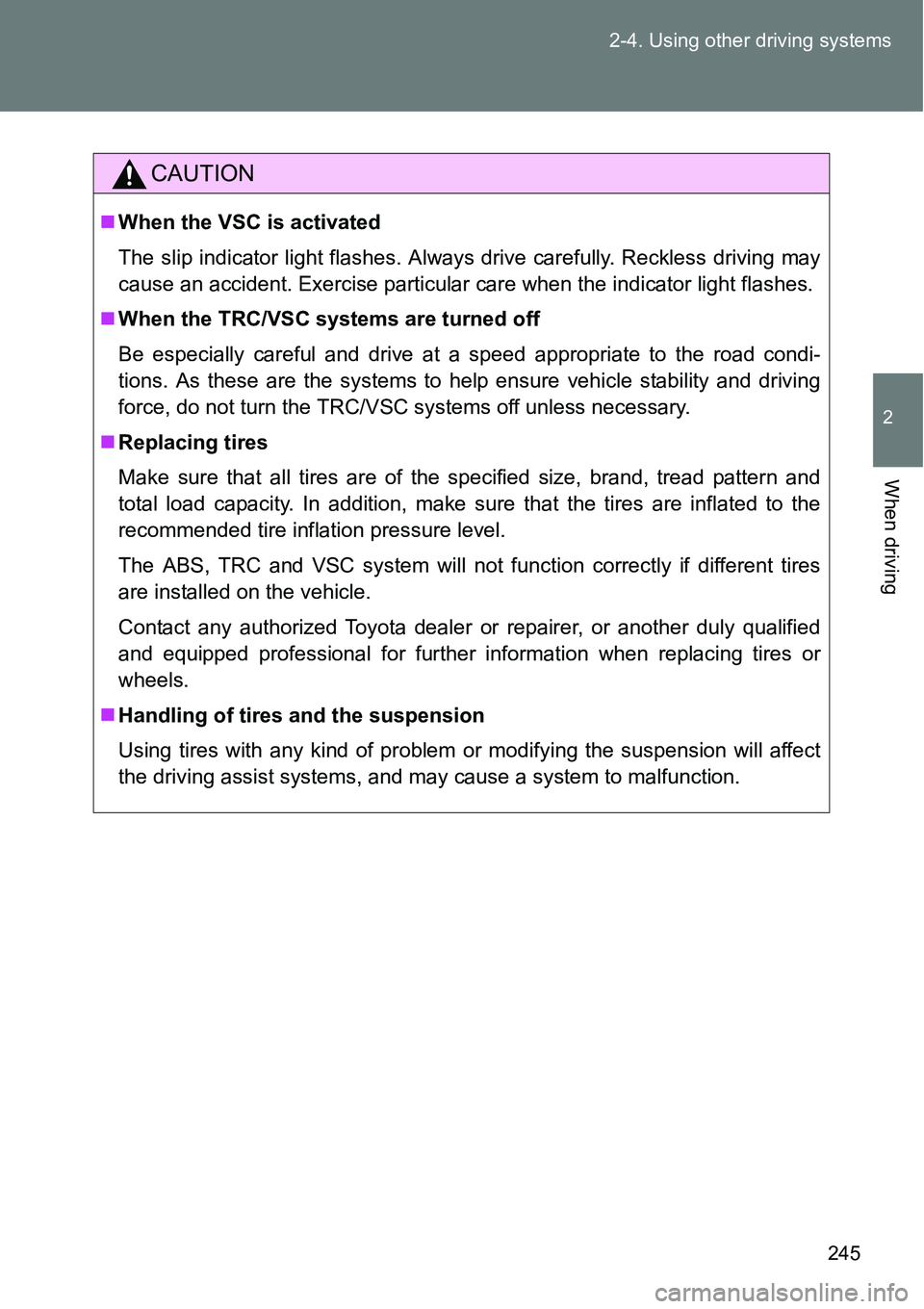
245 2-4. Using other driving systems
2
When driving
CAUTION
When the VSC is activated
The slip indicator light flashes. Always drive carefully. Reckless driving may
cause an accident. Exercise particular care when the indicator light flashes.
When the TRC/VSC systems are turned off
Be especially careful and drive at a speed appropriate to the road condi-
tions. As these are the systems to help ensure vehicle stability and driving
force, do not turn the TRC/VSC systems off unless necessary.
Replacing tires
Make sure that all tires are of the specified size, brand, tread pattern and
total load capacity. In addition, make sure that the tires are inflated to the
recommended tire inflation pressure level.
The ABS, TRC and VSC system will not function correctly if different tires
are installed on the vehicle.
Contact any authorized Toyota dealer or repairer, or another duly qualified
and equipped professional for further information when replacing tires or
wheels.
Handling of tires and the suspension
Using tires with any kind of problem or modifying the suspension will affect
the driving assist systems, and may cause a system to malfunction.
Page 248 of 564
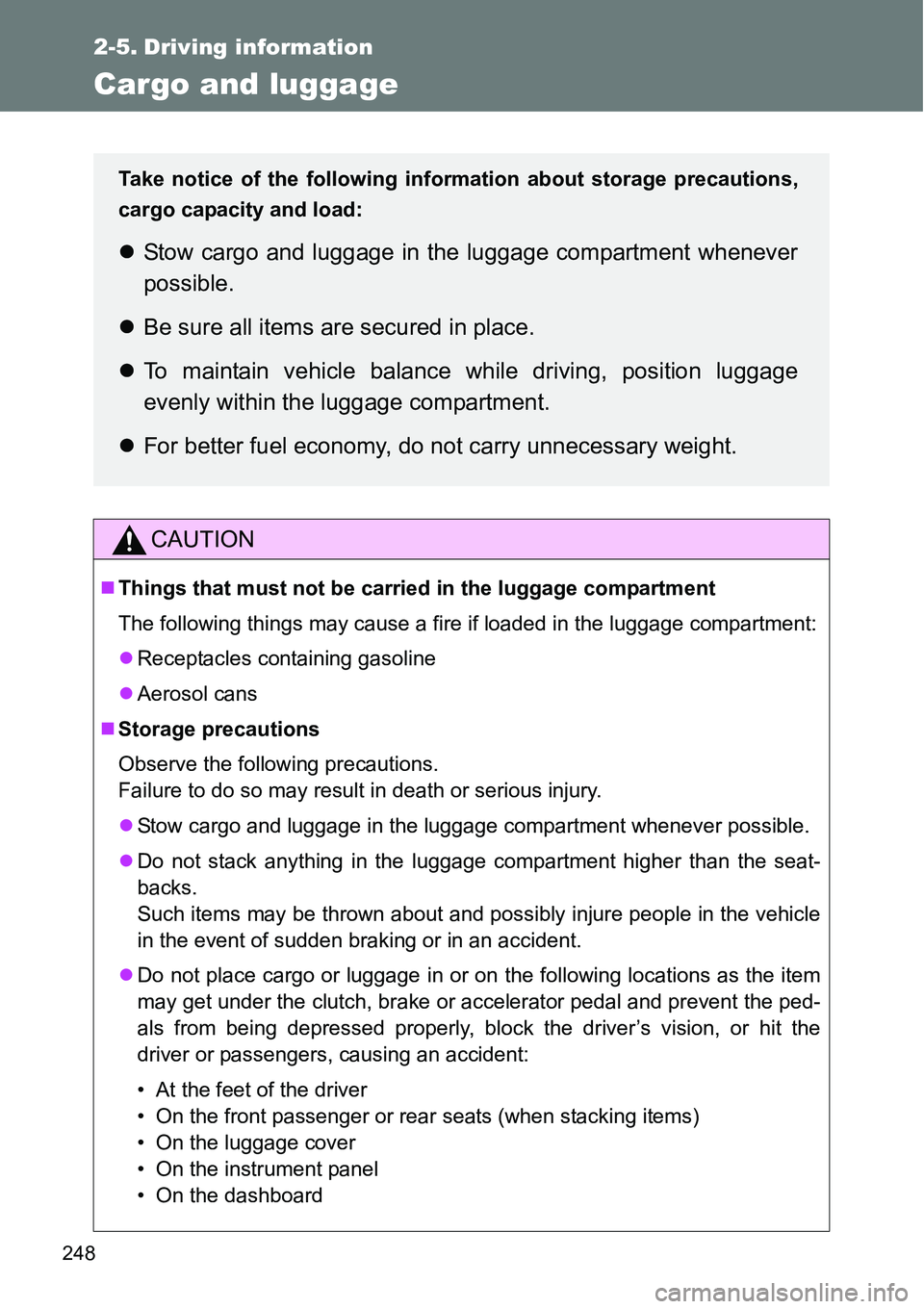
248
2-5. Driving information
Cargo and luggage
CAUTION
Things that must not be carried in the luggage compartment
The following things may cause a fire if loaded in the luggage compartment:
Receptacles containing gasoline
Aerosol cans
Storage precautions
Observe the following precautions.
Failure to do so may result in death or serious injury.
Stow cargo and luggage in the luggage compartment whenever possible.
Do not stack anything in the luggage compartment higher than the seat-
backs.
Such items may be thrown about and possibly injure people in the vehicle
in the event of sudden braking or in an accident.
Do not place cargo or luggage in or on the following locations as the item
may get under the clutch, brake or accelerator pedal and prevent the ped-
als from being depressed properly, block the driver’s vision, or hit the
driver or passengers, causing an accident:
• At the feet of the driver
• On the front passenger or rear seats (when stacking items)
• On the luggage cover
• On the instrument panel
• On the dashboard
Take notice of the following information about storage precautions,
cargo capacity and load:
Stow cargo and luggage in the luggage compartment whenever
possible.
Be sure all items are secured in place.
To maintain vehicle balance while driving, position luggage
evenly within the luggage compartment.
For better fuel economy, do not carry unnecessary weight.
Page 254 of 564
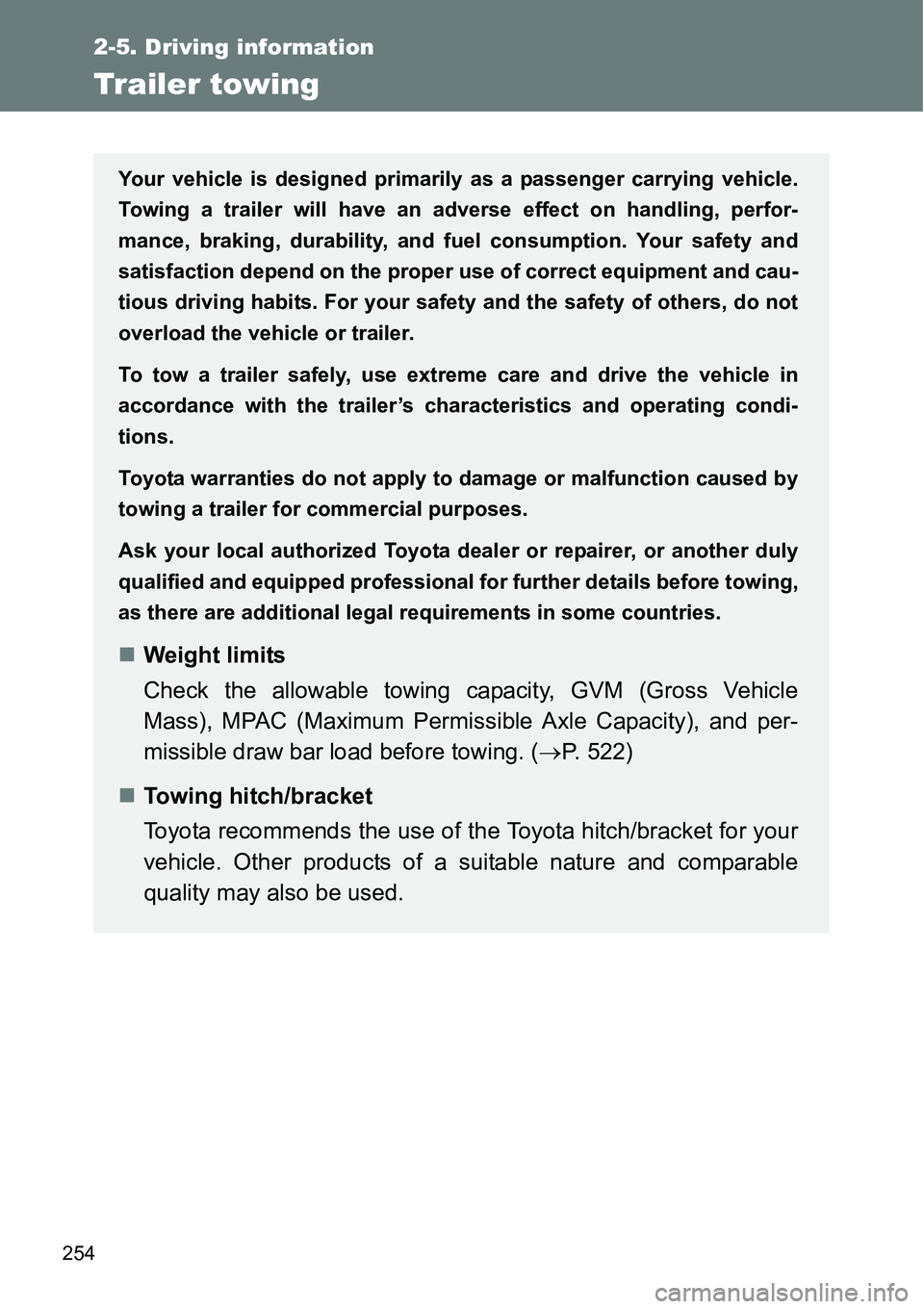
254
2-5. Driving information
Trailer towing
Your vehicle is designed primarily as a passenger carrying vehicle.
Towing a trailer will have an adverse effect on handling, perfor-
mance, braking, durability, and fuel consumption. Your safety and
satisfaction depend on the proper use of correct equipment and cau-
tious driving habits. For your safety and the safety of others, do not
overload the vehicle or trailer.
To tow a trailer safely, use extreme care and drive the vehicle in
accordance with the trailer’s characteristics and operating condi-
tions.
Toyota warranties do not apply to damage or malfunction caused by
towing a trailer for commercial purposes.
Ask your local authorized Toyota dealer or repairer, or another duly
qualified and equipped professional for further details before towing,
as there are additional legal requirements in some countries.
Weight limits
Check the allowable towing capacity, GVM (Gross Vehicle
Mass), MPAC (Maximum Permissible Axle Capacity), and per-
missible draw bar load before towing. (P. 522)
Towing hitch/bracket
Toyota recommends the use of the Toyota hitch/bracket for your
vehicle. Other products of a suitable nature and comparable
quality may also be used.
Page 255 of 564
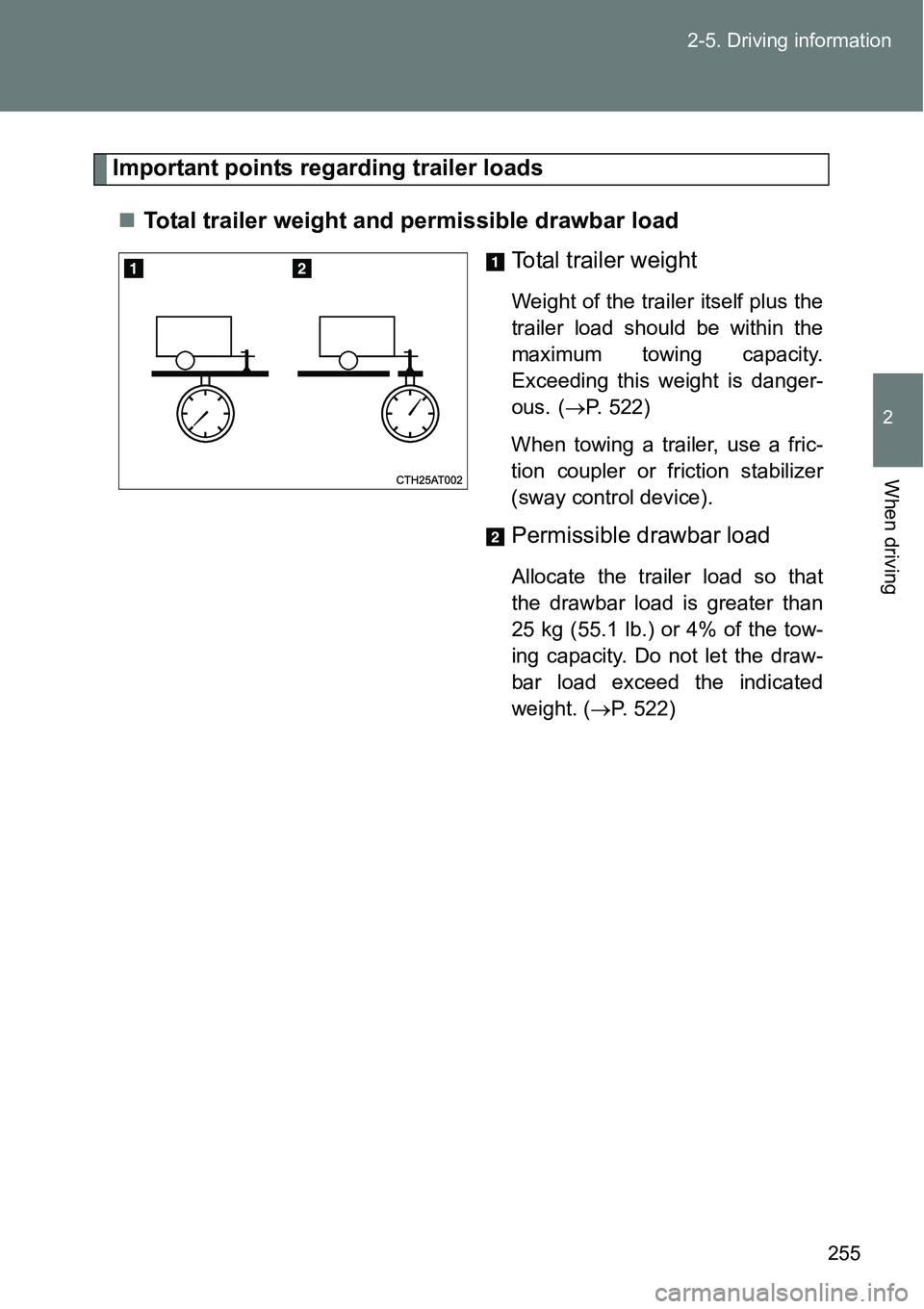
255 2-5. Driving information
2
When driving
Important points regarding trailer loads
Total trailer weight and permissible drawbar load
Total trailer weight
Weight of the trailer itself plus the
trailer load should be within the
maximum towing capacity.
Exceeding this weight is danger-
ous.
(P. 522)
When towing a trailer, use a fric-
tion coupler or friction stabilizer
(sway control device).
Permissible drawbar load
Allocate the trailer load so that
the drawbar load is greater than
25 kg (55.1 lb.) or 4% of the tow-
ing capacity. Do not let the draw-
bar load exceed the indicated
weight. (P. 522)
Page 256 of 564
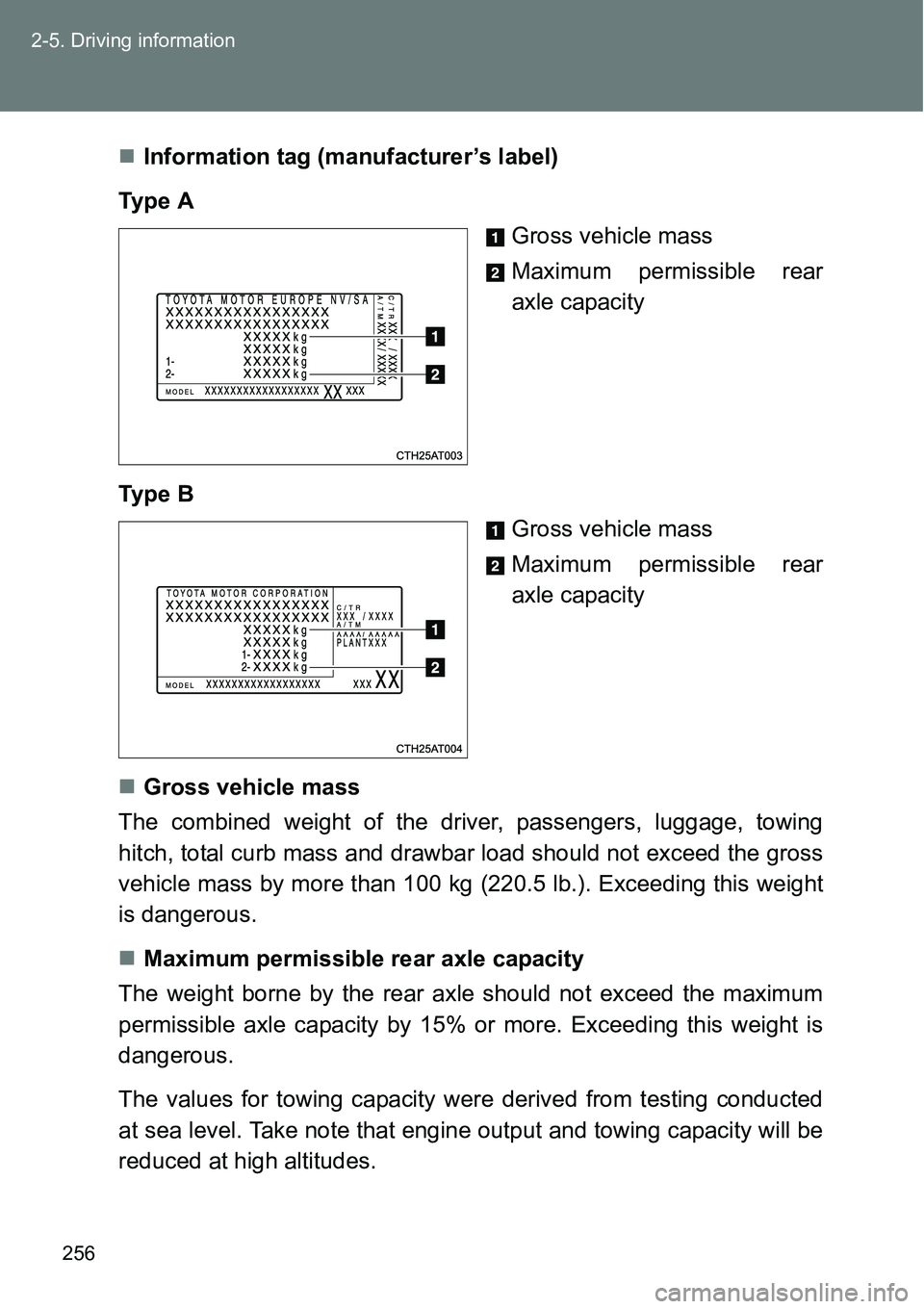
256 2-5. Driving information
Information tag (manufacturer’s label)
Ty p e A
Gross vehicle mass
Maximum permissible rear
axle capacity
Ty p e B
Gross vehicle mass
Maximum permissible rear
axle capacity
Gross vehicle mass
The combined weight of the driver, passengers, luggage, towing
hitch, total curb mass and drawbar load should not exceed the gross
vehicle mass by more than 100 kg (220.5 lb.). Exceeding this weight
is dangerous.
Maximum permissible rear axle capacity
The weight borne by the rear axle should not exceed the maximum
permissible axle capacity by 15% or more. Exceeding this weight is
dangerous.
The values for towing capacity were derived from testing conducted
at sea level. Take note that engine output and towing capacity will be
reduced at high altitudes.
Page 397 of 564
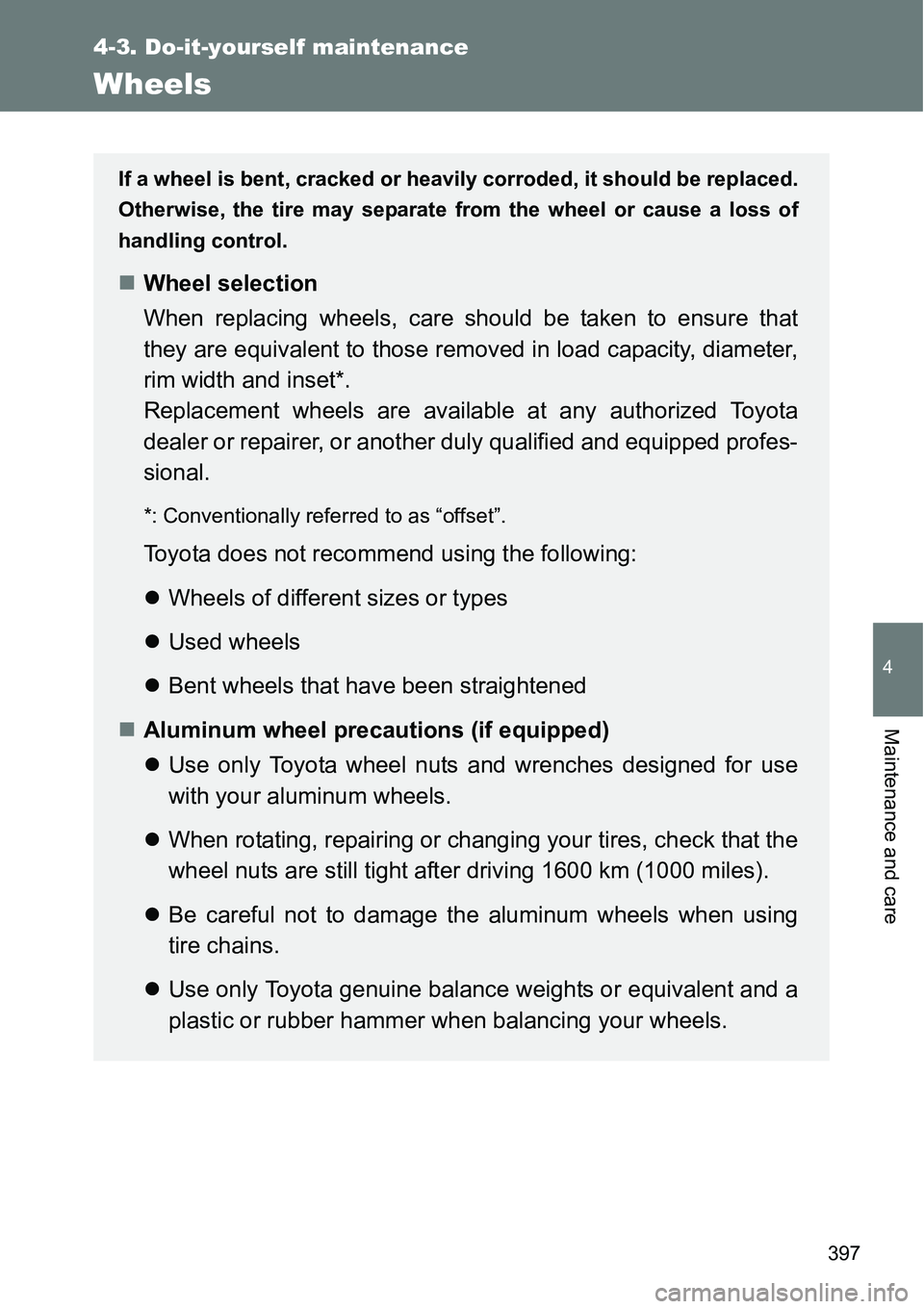
397
4-3. Do-it-yourself maintenance
4
Maintenance and care
Wheels
If a wheel is bent, cracked or heavily corroded, it should be replaced.
Otherwise, the tire may separate from the wheel or cause a loss of
handling control.
Wheel selection
When replacing wheels, care should be taken to ensure that
they are equivalent to those removed in load capacity, diameter,
rim width and inset*.
Replacement wheels are available at any authorized Toyota
dealer or repairer, or another duly qualified and equipped profes-
sional.
*: Conventionally referred to as “offset”.
Toyota does not recommend using the following:
Wheels of different sizes or types
Used wheels
Bent wheels that have been straightened
Aluminum wheel precautions (if equipped)
Use only Toyota wheel nuts and wrenches designed for use
with your aluminum wheels.
When rotating, repairing or changing your tires, check that the
wheel nuts are still tight after driving 1600 km (1000 miles).
Be careful not to damage the aluminum wheels when using
tire chains.
Use only Toyota genuine balance weights or equivalent and a
plastic or rubber hammer when balancing your wheels.
Page 523 of 564
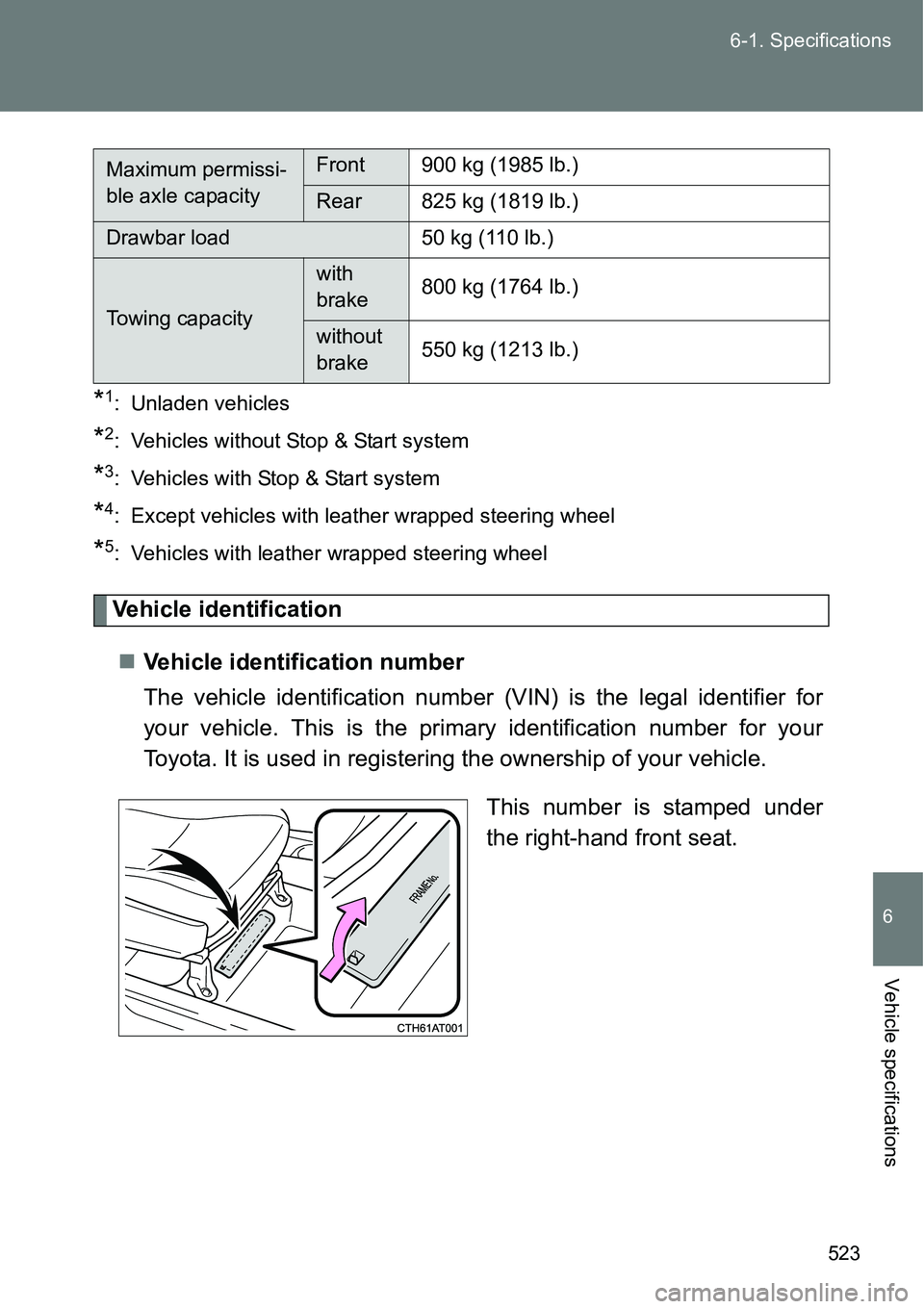
523 6-1. Specifications
6
Vehicle specifications
*1: Unladen vehicles
*2: Vehicles without Stop & Start system
*3: Vehicles with Stop & Start system
*4: Except vehicles with leather wrapped steering wheel
*5: Vehicles with leather wrapped steering wheel
Vehicle identification
Vehicle identification number
The vehicle identification number (VIN) is the legal identifier for
your vehicle. This is the primary identification number for your
Toyota. It is used in registering the ownership of your vehicle.
This number is stamped under
the right-hand front seat.
Maximum permissi-
ble axle capacityFront 900 kg (1985 lb.)
Rear 825 kg (1819 lb.)
Drawbar load 50 kg (110 lb.)
Towing capacity
with
brake800 kg (1764 lb.)
without
brake550 kg (1213 lb.)
Page 559 of 564
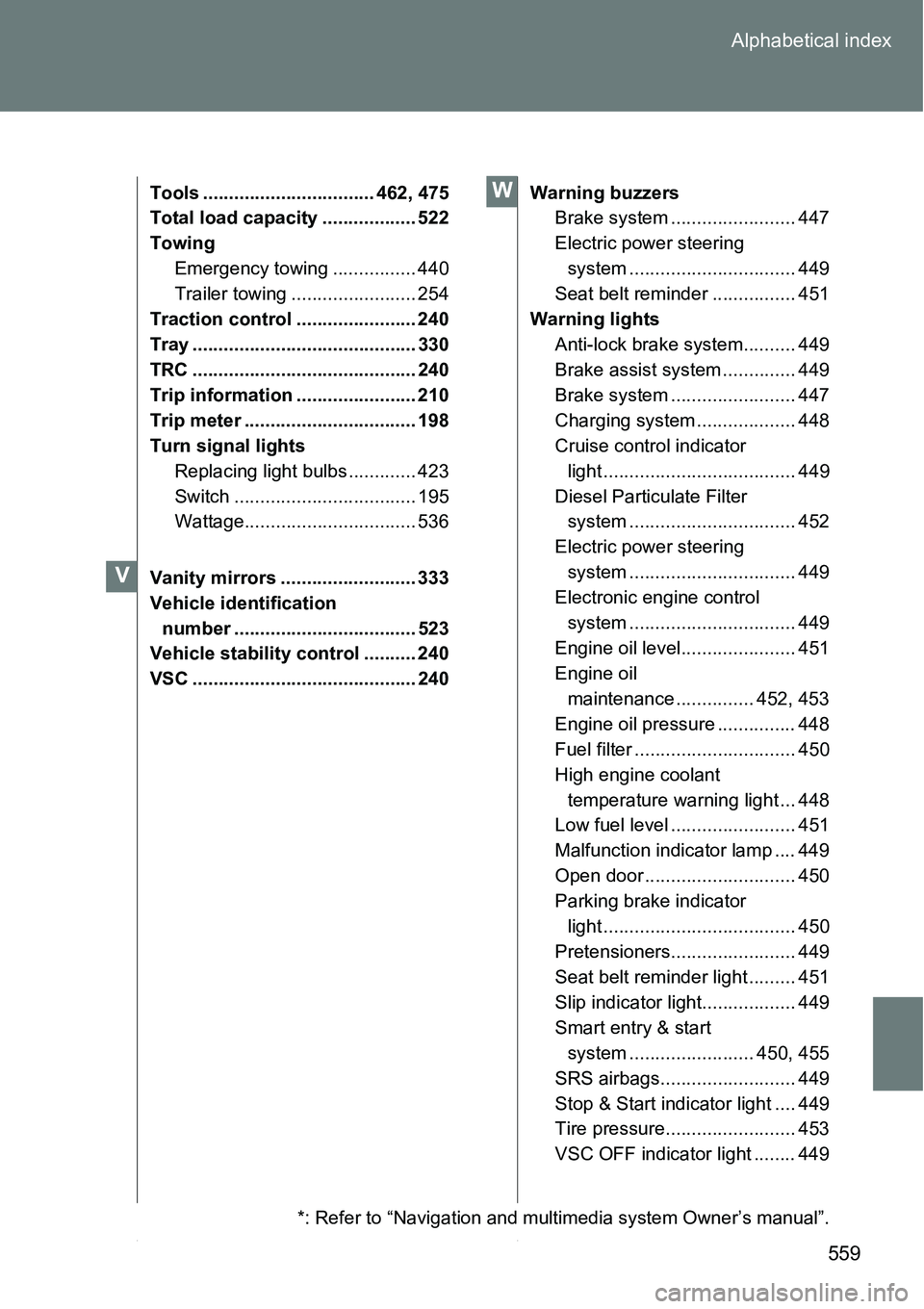
559 Alphabetical index
Tools ................................. 462, 475
Total load capacity .................. 522
Towing
Emergency towing ................ 440
Trailer towing ........................ 254
Traction control ....................... 240
Tray ........................................... 330
TRC ........................................... 240
Trip information ....................... 210
Trip meter ................................. 198
Turn signal lights
Replacing light bulbs ............. 423
Switch ................................... 195
Wattage................................. 536
Vanity mirrors .......................... 333
Vehicle identification
number ................................... 523
Vehicle stability control .......... 240
VSC ........................................... 240Warning buzzers
Brake system ........................ 447
Electric power steering
system ................................ 449
Seat belt reminder ................ 451
Warning lights
Anti-lock brake system.......... 449
Brake assist system .............. 449
Brake system ........................ 447
Charging system ................... 448
Cruise control indicator
light ..................................... 449
Diesel Particulate Filter
system ................................ 452
Electric power steering
system ................................ 449
Electronic engine control
system ................................ 449
Engine oil level...................... 451
Engine oil
maintenance ............... 452, 453
Engine oil pressure ............... 448
Fuel filter ............................... 450
High engine coolant
temperature warning light ... 448
Low fuel level ........................ 451
Malfunction indicator lamp .... 449
Open door ............................. 450
Parking brake indicator
light ..................................... 450
Pretensioners........................ 449
Seat belt reminder light ......... 451
Slip indicator light.................. 449
Smart entry & start
system ........................ 450, 455
SRS airbags.......................... 449
Stop & Start indicator light .... 449
Tire pressure......................... 453
VSC OFF indicator light ........ 449
V
*: Refer to “Navigation and multimedia system Owner’s manual”.
W